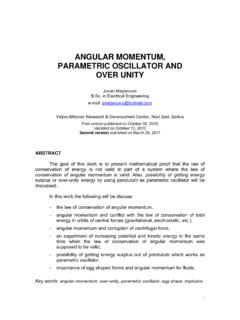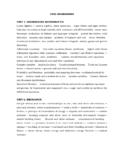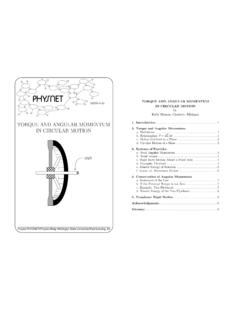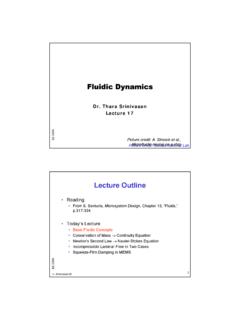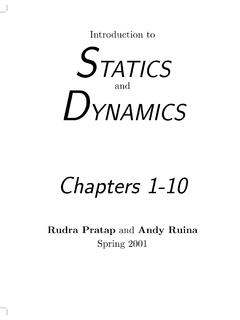Transcription of Momentum Transfer Analysis of the Collapse of the …
1 Journal of 9/11 Studies 32 June 2006/Volume 1 Momentum Transfer Analysis of the Collapse of the Upper Storeys of WTC 1 Author: The author of this work, Gordon Ross, was born in Dundee, Scotland. He holds degrees in both Mechanical and Manufacturing Engineering, graduating from Liverpool John Moores University, in 1984. He can be contacted at Summary: This paper examines the elastic loading and plastic shortening phases of the columns of WTC 1 after impact of the upper 16 storeys of the building upon the lower storeys and its effect on the Momentum Transfer after the collision. An energy balance is derived showing that there is an energy deficit before completion of the plastic shortening phase that would not allow the Collapse to continue under the constraints of this paper.
2 Introduction: Previous Analysis of the Momentum Transfer in the Collapse of the towers has viewed them as being floors suspended in space and have examined the Momentum Transfer as a series of elastic or inelastic collisions, which are independent of each other. This type of Analysis takes the Momentum Transfer out of the context given by the other effects of the collisions. This is because this type of Analysis assumes that the impacts have an effect upon only the topmost storey of the impacted section. The reality of the situation is that the impacts would have an effect upon several storeys in the lower section and for a valid Analysis all of these Momentum transfers must be included.
3 If we assume that the upper section comprising 16 storeys falls under a full gravitational acceleration through a height of one (removed) storey, a distance of metres we can calculate that its velocity upon impact will be metres per second and have a kinetic energy due to its mass and velocity of GJ. (Using the figure of 58000 tonnes as detailed in the report by Bazant & Zhou.[1]) In reality there would be some losses of energy due to residual strength within the failing columns of the removed section, but these are ignored for the purposes of this Analysis . Upon impact with the lower section the falling mass would deliver a force which would grow from zero, up to the failure load of the impacted storey columns, over a finite period of time and distance.
4 This force would also be felt by the columns below the storey which was first impacted. Analysis : The falling upper section with a velocity of no more than metres per second at impact would meet resistance from the impacted columns and have as its first task the necessity to load these columns through their elastic range and thereafter through the plastic shortening phase. We shall firstly examine this incremental time period. Bazant/Zhou [1] show in their Analysis that elastic and plastic behaviour of a steel column under a dynamic buckling load can be shown to consist of three distinct phases. These can be Journal of 9/11 Studies 33 June 2006/Volume 1 shown on a load against vertical deflection graph and consist of an initial elastic phase, a shortening phase and a rapid plastic deformation phase.
5 1/ The elastic phase shows a linear relationship between load and deflection up to the elastic limit. The load at this point is the failure load and the deflection at the elastic limit for steel is generally of the initial length. 2/ The shortening phase allows for the same failure load to be applied until the vertical deformation reaches 3% at which point the column begins to form buckle points. 3/ The third phase shows a rapid decrease in the load requirement to continue deformation, this load necessarily being less than the failure load. This phase lasts until the total vertical deformation equals the original length. In other words the column is bent in two.
6 To shorten the columns of the first impacted storey by 3%, sufficient to complete the plastic shortening phase, a distance of about metres, and allowing a constant speed of metres per second, would take a minimum of seconds. The speed of the propagation wave through a medium is given by the general formula for wave propagation Velocity = Square root ( Bulk modulus / Density ), and for structural steel is of the order of 4500 metres per second. The propagation wave of the impact force would therefore travel a distance of metres in a time of seconds. This means that during the time taken in the plastic shortening of the impacted columns, the same force would be felt at a minimum distance of metres, or approximately 16 storeys, from the impact.
7 These storeys would thus suffer an elastic deflection in response to, and proportional to, the failure load applied at the impacted floor. These deflections would themselves take time and allow the propagation wave to move further downwards again affecting more storeys. We can estimate the elastic deflection of these 16 storey columns as being in the range 0 to 7mm. The full elastic deflection of a column, using the generally accepted figure of of its original length is The columns in the uppermost of these storeys would suffer almost their full elastic deflection since their failure load is similar though slightly greater than that of the first impacted storey.
8 Those storey columns more distant from the impact would be of a larger cross section, requiring higher loads to cause full elastic deflection. Using only half of the maximum elastic deflection, 56mm (16 * 7 / 2), is, again, an assumption in favour of Collapse continuation. The elastic deflection of lower storeys would increase the distance through which the falling section would have to move in order to load the impacted column and complete its 3% plastic shortening. The time taken, again using a constant velocity of m/sec would increase to about seconds, and thus allow the propagation wave to move through and affect a further 8 storeys.
9 Journal of 9/11 Studies 34 June 2006/Volume 1 Because these columns suffer a vertical deflection, the attached floors move downwards and they will therefore have a velocity and Momentum . Energy Losses: A simple conservation of Momentum calculation, ignoring these movements, would have, 16 falling storeys moving at m/sec before impact, changing to 17 storeys moving at ( * (16/17)) = 8 m/sec after impact. This does not reflect the fact that a minimum of 24 further storeys will be caused to move downwards at varying speeds. To estimate and illustrate the further Momentum changes we can assume that the storey which is 25 storeys from the impact remains static and the velocity of the 24 affected storeys will vary linearly from the velocity of the falling section to zero.
10 Momentum before impact = 16 storeys moving at m/sec Momentum after impact = 17 storeys moving at V2 m/sec + 1 storey moving at 23/24*V2 m/sec + 1 storey moving at 22/24*V2m/sec +..+ 1 storey moving at 2/24*V2 m/sec + 1 storey moving at 1/24*V2m/sec 16* = V2 (17 + ) V2 = 16 * / = metres per second. The speed of the upper section would be reduced by the collision from m/sec to a speed of less than m/sec rather than the 8 m/sec derived from a Momentum calculation which does not include this factor. Note also that this reduction in speed would again give more time for the propagation wave to travel downwards through the tower columns and allow that more and more storeys are so affected.


